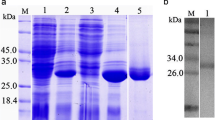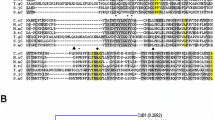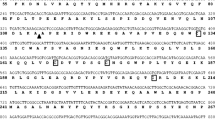Abstract
Cysteine proteases, a superfamily of hydrolytic enzymes, have numerous functions in parasites. Here, we reported the cloning and characterization of a cDNA encoding a cathepsin B (AcCPB) from Angiostrongylus cantonensis fourth-stage larvae cDNA library. The deduced amino acid sequence analysis indicated AcCPB is related to other cathepsin B family members with an overall conserved architecture. AcCPB is evolutionarily more close to other parasitic nematode cathepsin B than the ones from hosts, sharing 43–53% similarities to the homologues from other organisms. Real-time quantitative PCR analysis revealed that AcCPB was expressed significantly higher in the fourth-stage larvae (L4) and the fifth-stage larvae (L5) than that in the third-stage larvae (L3) and adult worms (Aw). Unexpectedly, AcCPB was expressed at a higher level in L4 and L5 derived from mice than the larvae at the same stages derived from rats. The protease activity of recombinant AcCPB (rAcCPB) expressed in Escherichia coli showed high thermostability and acidic pH optima. The role in ovalbumin digestion and enzyme activity of rAcCPB could be evidently inhibited by cystatin from A.cantonensis. Furthermore, we found rAcCPB increased the expression levels of CD40, MHC II, and CD80 on LPS-stimulated dendritic cells (DCs). In this study, we provided the first experimental evidence for the expression of cathepsin B in A.cantonensis. Besides its highly specific expression in the stages of L4 and L5 when the worms cause dysfunction of the blood–brain barrier of hosts, AcCPB displayed different expression profiles in non-permissive host- and permissive host-derived larval stages and was involved in the maturation of DCs, suggesting a potential role in the central nervous system invasion and the immunoregulation during parasite–host interactions.









Similar content being viewed by others
References
Alexander J, Coombs GH, Mottram JC (1998) Leishmania mexicana cysteine proteinase-deficient mutants have attenuated virulence for mice and potentiate a Th1 response. J Immunol 161(12):6794–6801
Alicata JE (1965) Biology and distribution of the rat lungworm, Angiostrongylus cantonensis, and its relationship to eosinophilic meningoencephalitis and other neurological disorders of man and animals. Adv Parasitol 3:223–248
Atkinson HJ, Babbitt PC, Sajid M (2009) The global cysteine peptidase landscape in parasites. Trends Parasitol 25(12):573–581
Banchereau J, Steinman RM (1998) Dendritic cells and the control of immunity. Nature 392(6673):245–252
Banchereau J, Briere F, Caux C, Davoust J, Lebecque S, Liu YJ, Pulendran B, Palucka K (2000) Immunobiology of dendritic cells. Annu Rev Immunol 18:767–811
Bergeron M, Blanchette J, Rouleau P, Olivier M (2008) Abnormal IFN-gamma- dependent immunoproteasome modulation by Trypanosoma cruzi-infected macrophages. Parasite Immunol 30(5):280–292
Dalton JP, Neill SO, Stack C, Collins P, Walshe A, Sekiya M, Doyle S, Mulcahy G, Hoyle D, Khaznadji E, Moiré N, Brennan G, Mousley A, Kreshchenko N, Maule AG, Donnelly SM (2003) Fasciola hepatica cathepsin L-like proteases:biology, function, and potential in the development of first generation liver fluke vaccines. Int J Parasitol 33(11):1173–1181
Dalton JP, Caffrey CR, Sajid M, Stack C, Donnelly S, Loukas A, Don T, McKerrow J, Halton DW, Brindley PJ (2006) Proteases in trematode biology. In: Maule A, Marks NJ (eds) Parasitic Flatworms, Molecular biology, Biochemistry. Immunology and Physiology. CABI Publishing, Oxford, UK, pp 348–368
Dolecková K, Kasný M, Mikes L, Cartwright J, Jedelský P, Schneider EL, Dvorák J, Mountford AP, Craik CS, Horák P (2009) The functional expression and characterisation of a cysteine peptidase from the invasive stage of the neuropathogenic schistosome Trichobilharzia regenti. Int J Parasitol 39(2):201–211
Draper D, Donohoe W, Mortimer L, Heine RP (1998) Cysteine proteases of Trichomonas aginalis degrade secretory leukocyte protease inhibitor. J Infect Dis 178(3):815–819
Duschak VG, Couto AS (2009) Cruzipain, the major cysteine protease of Trypanosoma cruzi: a sulfated glycoprotein antigen as relevant candidate for vaccine development and drug target. A review. Curr Med Chem 16(24):3174–3202
Dvorak J, Mashiyama ST, Braschi S, Sajid M, Knudsen GM, Hansell E, Lim KC, Hsieh I, Bahgat M, Mackenzie B, Medzihradszky KF, Babbitt PC, Caffrey CR, McKerrow JH (2008) Differential use of protease families for invasion by schistosome cercariae. Biochimie 90(2):345–358
Fuller AL, McDougald LR (1990) Reduction in cell entry of Eimeria tenella (Coccidia) sporozoites by protease inhibitors, and partial characterization of proteolytic activity associated with intact sporozoites and merozoites. Parasitology 76(4):464–467
Ghoneim H, Klinkert MQ (1995) Biochemical properties of purified cathepsin B from Schistosoma mansoni. Int J Parasitol 25(12):1515–1519
He H, Cheng M, Yang X, Meng J, He A, Zheng X, Li Z, Guo P, Pan Z, Zhan X (2009) Preliminary molecular characterization of the human pathogen Angiostrongylus cantonensis. BMC Mol Biol 10:97
Hüttemann M, Schmahl G, Mehlhorn H (2007) Light and electron microscopic studies on two nematodes, Angiostrongylus cantonensis and Trichuris muris, differing in their mode of nutrition. Parasitol Res 101(Suppl 2):S225–S232
Jindrak K, Alicata JE (1970) Experimentally induced Angiostrongylus cantonensis infection in dogs. Am J Vet Res 31(3):449–456
Lee JD, Yen CM (2005) Protease secreted by the infective larvae of Angiostrongylus cantonensis and its role in the penetration of mouse intestine. Am J Trop Med Hyg 72(6):831–836
Lee JD, Tsai LY, Chen CH, Wang JJ, Hsiao JK, Yen CM (2006) Blood-brain barrier dysfunction occurring in mice infected with Angiostrongylus cantonensis. Acta Trop 97(2):204–211
Liu YH, Han YP, Li ZY, Wei J, He HJ, Xu CZ, Zheng HQ, Zhan XM, Wu ZD, Lv ZY (2010) Molecular cloning and characterization of cystatin, a cysteine protease inhibitor, from Angiostrongylus cantonensis. Parasitol Res 107(4):915–922
Livak KJ, Schmittgen TD (2001) Analysis of relative gene expression data using real-time quantitative PCR and the 2(-Delta Delta C(T)) method. Methods 25(4):402–408
Lowther J, Robinson MW, Donnelly SM, Xu W, Stack CM, Matthews JM, Dalton JP (2009) The importance of pH in regulating the function of the Fasciola hepatica cathepsin L1 cysteine protease. PLoS Negl Trop Dis 3(1):e369
Lutz MB, Kukutsch N, Ogilvie AL, Rössner S, Koch F, Romani N, Schuler G (1999) An advanced culture method for generating large quantities of highly pure dendritic cells from mouse bone marrow. J Immunol Meth 223(1):77–92
McKerrow JH, Engel JC, Caffrey CR (1999) Cysteine protease inhibitors as chemotherapy for parasitic infections. Bioorg Med Chem 7(4):639–644
McKerrow JH, Caffrey C, Kelly B, Loke P, Sajid M (2006) Proteases in parasitic diseases. Annu Rev Pathol 1:497–536
Mendieta L, Picó A, Tarragó T, Teixidó M, Castillo M, Rafecas L, Moyano A, Giralt E (2010) Novel peptidyl aryl vinyl sulfones as highly potent and selective inhibitors of cathepsins L and B. ChemMedChem 5(9):1556–1567
Nagano I, Pei F, Wu Z, Wu J, Cui H, Boonmars T, Takahashi Y (2004) Molecular expression of a cysteine proteinase of Clonorchis sinensis and its application to an enzyme-linked immunosorbent assay for immunodiagnosis of clonorchiasis. Clin Diagn Lab Immunol 11(2):411–416
Nikolskaia OV, de A-Lima AP, Kim YV, Lonsdale-Eccles JD, Fukuma T, Scharfstein J, Grab DJ (2006) Blood-brain barrier traversal by African trypanosomes requires calcium signaling induced by parasite cysteine protease. J Clin Invest 116(10):2739–2747
Que X, Reed SL (2000) Cysteine proteinases and the pathogenesis of amebiasis. Clin Microbiol Rev 13(2):196–206
Que X, Ngo H, Lawton J, Gray M, Liu Q, Engel J, Brinen L, Ghosh P, Joiner KA, Reed SL (2002) The cathepsin B of Toxoplasma gondii, toxopain-1, is critical for parasite invasion and rhoptry protein processing. J Biol Chem 277(28):25791–25797
Ramirez-Avila L, Slome S, Schuster FL, Gavali S, Schantz PM, Sejvar J, Glaser CA (2009) Eosinophilic meningitis due to Angiostrongylus and Gnathostoma species. Clin Infect Dis 48(3):322–327
Reed SL (1995) New concepts regarding the pathogenesis of amebiasis. Clin Infect Dis 21(2):S182–S185
Robinson MW, Dalton JP, Donnelly S (2008) Helminth pathogen cathepsin proteases: it's a family affair. Trends Biochem Sci 33(12):601–608
Saitou N, Nei M (1987) The neighbor-joining method: a new method for reconstructing phylogenetic trees. Mol Biol Evol 4(4):406–425
Sajid M, McKerrow JH (2002) Cysteine proteases of parasitic organisms. Mol Biochem Parasitol 120(1):1–21
Schrével J, Barrault C, Deguercy A, Grellier P, Lawton P, Heidrich HG, Caballero M, Monsigny M, Mayer R (1993) Plasmodium falciparum proteinases and red blood cell invasion. Parassitologia 35(Suppl):103–105
Shenai BR, Sijwali PS, Singh A, Rosenthal PJ (2000) Characterization of native and recombinant falcipain-2, a principal trophozoite cysteine protease and essential hemoglobinase of Plasmodium falciparum. J Biol Chem 275(37):29000–29010
Smooker PM, Jayaraj R, Pike RN, Spithill TW (2010) Cathepsin B proteases of flukes: the key to facilitating parasite control? Trends Parasitol 26(10):506–514
Tort J, Brindley PJ, Knox D, Wolfe KH, Dalton JP (1999) Proteinases and associated genes of parasitic helminths. Adv Parasitol 43:161–266
Tsai HC, Chung LY, Chen ER, Liu YC, Lee SS, Chen YS, Sy CL, Wann SR, Yen CM (2008) Association of matrix metalloproteinase-9 and tissue inhibitors of metalloproteinase-4 in cerebrospinal fluid with blood-brain barrier dysfunction in patients with eosinophilic meningitis caused by Angiostrongylus cantonensis. Am J Trop Med Hyg 78(1):20–27
Turk D, Guncar G (2003) Lysosomal cysteine proteases (cathepsins): promising drug targets. Acta Crystallogr D Biol Crystallogr 59(Pt 2):203–213
Vary B, Hartmann S, Hoebeke J (2002) Immunomodulatory properties of cystatins. Cell Mol Life Sci 59(9):1503–1512
Wolfram M, Ilg T, Mottram JC, Overath P (1995) Antigen presentation by Leishmania mexicana-infected macrophages: activation of helper T cells specific for amastigote cysteine proteinases requires intracellular killing of the parasites. Eur J Immunol 25(4):1094–1000
Wongkham C, Tantrawatpan C, Intapan PM, Maleewong W, Wongkham S, Nakashima K (2005) Evaluation of immunoglobulin G subclass antibodies against recombinant Fasciola gigantica cathepsin L1 in an enzyme-linked immunosorbent assay for serodiagnosis of human fasciolosis. Clin Diagn Lab Immunol 12(10):1152–1156
Acknowledgments
We are grateful to Dr. Jue-heng Wu, Yue Zhu, Sen-mao Li, Li-li Zhang, and Zi-ran Zhao for their expert technical assistances in mass spectrometry, fluorescence microplate reader and assay for enzyme activity. This work was supported by grants from the National Basic Research Program of China (2010CB530004), the National Natural Science Foundation of China (30771888, 30800966), and Research Fund for Students of Sun Yat-sen University (2011).
Author information
Authors and Affiliations
Corresponding authors
Rights and permissions
About this article
Cite this article
Han, Yp., Li, Zy., Li, Bc. et al. Molecular cloning and characterization of a cathepsin B from Angiostrongylus cantonensis . Parasitol Res 109, 369–378 (2011). https://doi.org/10.1007/s00436-011-2264-0
Received:
Accepted:
Published:
Issue Date:
DOI: https://doi.org/10.1007/s00436-011-2264-0




